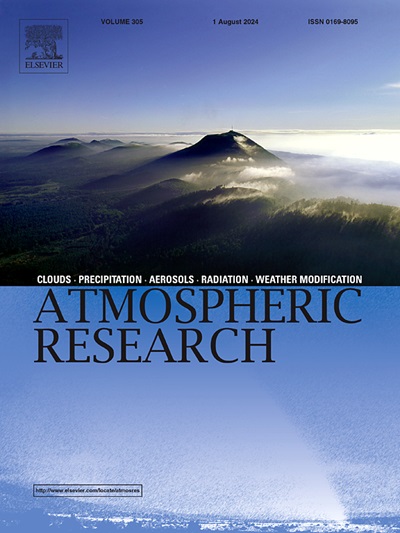A time-invariant bias correction strategy for improving CLM5.0 evapotranspiration simulation by random forest method for mainland China
IF 4.5
2区 地球科学
Q1 METEOROLOGY & ATMOSPHERIC SCIENCES
引用次数: 0
Abstract
Reliable and accurate estimation of large-scale evapotranspiration (ET) is fundamental for research in Earth System Science, however, large-scale ET estimation remains a challenge. Bias correction of the land surface model (LSM) simulated ET is a popular approach for providing large-scale, long-term estimations. Previous correction methods often ignore stochastic errors, making them unsuitable for complex conditions. Therefore, this study evaluated the performance of the Community Land Model 5.0 (CLM 5.0) in simulating ET based on the Global Land Evaporation Amsterdam Model (GLEAM) product and in situ observations across mainland China, analyzed the main factors influencing model performance, developed a time-variant bias correction strategy using the random forest (RF) method. Results show that precipitation is crucial in influencing the performance and uncertainty of CLM 5.0 simulations since it determines whether ET is limited by energy or water. The CLM 5.0 performed worse but with lower uncertainty in water-limited regions due to soil water stress, while it performed better but with higher uncertainty in energy-limited regions. Future research should focus on refining the depth limits of dry surface layer (DSL) parameterization to improve model performance in water-limited regions. Furthermore, the CLM 5.0 overestimated ET in the Northern China (NC) region but underestimated ET in the other seven regions. The overestimation is attributed to the model's overestimation of leaf area index and the underestimation of GLEAM data in farmland. After bias correction, the national average correlation coefficients (R) increased by 0.102, root mean square errors (RMSE) decreased by 0.178 mm/d, absolute mean bias (BIAS) values decreased by 0.006 mm/d, Kling-Gupta efficiency (KGE) values increased by 0.154, and uncertainty coefficients with 95 % confidence level (U95%) decreased by 0.195 mm/d. The performance of bias corrected simulations is significantly improved. The trends of both overestimation and underestimation of ET simulations by CLM 5.0 at a regional scale have also been alleviated. The time-invariant bias correction strategy proposed in this study demonstrates more reliable performance compared to the previous studies that applied monthly scaling factors. This advancement is essential for estimating more reliable large-scale ET under complex conditions.
中国大陆地区随机森林法CLM5.0蒸散发模拟的时不变偏差校正策略
大尺度蒸散发(ET)的可靠和准确估算是地球系统科学研究的基础,但大尺度蒸散发的估算仍然是一个挑战。地表模式(LSM)模拟蒸散发的偏差校正是提供大尺度、长期估算的常用方法。以往的校正方法往往忽略随机误差,不适合复杂条件。因此,本研究基于全球土地蒸发阿姆斯特丹模型(GLEAM)产品和中国大陆地区的实地观测,评估了社区土地模型5.0 (CLM 5.0)模拟ET的性能,分析了影响模型性能的主要因素,并采用随机森林(RF)方法制定了时变偏差校正策略。结果表明,降水是影响CLM 5.0模拟性能和不确定性的关键因素,因为它决定了ET是受能量还是水的限制。CLM 5.0在土壤水分胁迫的限水区表现较差但不确定性较低,在能源限制区表现较好但不确定性较高。未来的研究应侧重于细化干表面层(DSL)参数化的深度限制,以提高模型在限水地区的性能。此外,CLM 5.0高估了华北地区的蒸散发,而低估了其他7个地区的蒸散发。高估的原因是模型高估了耕地叶面积指数,低估了GLEAM数据。偏差校正后,全国平均相关系数(R)提高了0.102,均方根误差(RMSE)降低了0.178 mm/d,绝对平均偏差(bias)值降低了0.006 mm/d,克林-古普达效率(KGE)值提高了0.154,95%置信水平(U95%)的不确定性系数(U95%)降低了0.195 mm/d。偏差校正仿真的性能得到了显著提高。clm5.0在区域尺度上对ET模拟高估和低估的趋势也有所缓解。本研究提出的时不变偏差校正策略与以往应用月标度因子的研究相比,表现出更可靠的性能。这一进展对于在复杂条件下估计更可靠的大尺度ET至关重要。
本文章由计算机程序翻译,如有差异,请以英文原文为准。
求助全文
约1分钟内获得全文
求助全文
来源期刊

Atmospheric Research
地学-气象与大气科学
CiteScore
9.40
自引率
10.90%
发文量
460
审稿时长
47 days
期刊介绍:
The journal publishes scientific papers (research papers, review articles, letters and notes) dealing with the part of the atmosphere where meteorological events occur. Attention is given to all processes extending from the earth surface to the tropopause, but special emphasis continues to be devoted to the physics of clouds, mesoscale meteorology and air pollution, i.e. atmospheric aerosols; microphysical processes; cloud dynamics and thermodynamics; numerical simulation, climatology, climate change and weather modification.
 求助内容:
求助内容: 应助结果提醒方式:
应助结果提醒方式:


